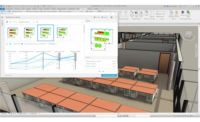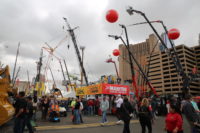A law passed last fall requiring new construction and expansions in Madison, Wis., to include bird-safe designs and materials has been formally challenged by an advocacy group representing several Wisconsin construction and real estate industry associations.
The group, Wisconsin Institute for Law & Liberty, filed a notice of claim with the City of Madison Common Council on March 3, asserting that the city’s recently passed ordinance on bird-safe building materials is pre-empted by Wisconsin’s unified building code. WILL is representing four groups: the Associated Builders and Contractors of Wisconsin, the Commercial Association of Realtors of Wisconsin, the Wisconsin Builders Association, and NAOIP Wisconsin, a commercial real estate group.
The Madison Common Council unanimously adopted the ordinance in August 2020, requiring new construction and expansions in the city to use bird-safe designs and materials to allow birds to better see glass facades and avoid collisions. The standard was developed in cooperation with the American Bird Conservancy and the University of Wisconsin-Madison. It went into effect in October.
Collisions with buildings are the second-leading cause of bird deaths in the U.S., with the U.S. Fish and Wildlife Service estimating nearly one billion bird deaths per year linked to building collisions. Almost all these collisions happen with low-rise buildings, typically 11 stories or less.
Several large municipalities in North America have passed similar ordinances requiring the use of bird-safe designs and materials, including New York City, San Francisco and Toronto. Typically, bird-safe design strategies involve the use of glass with patterns or other visual interruptions to deter birds. These can include fritted or etched glass, aftermarket films applied to glass, or specially made glass with patterned layers of ultraviolet materials that birds can see, but are not easily visible to humans. Some of these UV glass systems can come at a price premium, as many glass manufacturers still consider them a niche product. Building designs can also deter bird collisions by limiting the use of large glass surfaces on the first few stories of a structure's facade and avoiding layouts with "fly-through" corridors that attract birds.
WILL does not typically file petitions or suits on behalf of Wisconsin’s construction-related industries, but the group considers this particular issue to be a matter of regulatory overreach, according to its deputy council, Dan Lennington. “This falls into our category of rule of law and economic liberty. People who make business decisions should have certainty,” he says, adding that the notice of claim WILL filed is not linked to any specific construction project planned or underway within the City of Madison. Lennington says that the Wisconsin Commercial Building Code preempts the local bird-safe ordinance, and does not allow for local governments to enact additional requirements for builders. “We are not making any policy judgement on whether bird-safe glass is good to use. It’s a matter of uniformity of principle.”
The City of Madison has not yet taken up the notice of claim, but a representative of the city’s attorney’s office told ENR it rejects WILL’s reasoning on the matter. “Madison’s bird-glass ordinance is a valid exercise of the City’s zoning authority and does not set construction standards that are preempted by the state building code,” says John Strange, assistant city attorney for the City of Madison. “The City will process WILL’s claim like it processes all other claims, with the Common Council ultimately approving or denying the claim.”
Lennington says if the Madison Common Council does not strike down the ordinance, WILL plans to file a lawsuit this summer and seek a summary judgement from either the Wisconsin Court of Appeals or the Wisconsin Supreme Court. “We would like for a precedent set statewide to say local tinkering with the building code is not permitted under state law,” he tells ENR.
While there have not been many high-profile legal challenges to bird-safe design requirements, it is possible that other objections could be raised as more bird-safe ordinances are passed. New York City adopted a bird-safe design regulation in 2019, that went into effect in January, 2021, requiring all new construction to adopt bird-safe materials and design approaches. Last July, the U.S. House of Representatives passed a bill requiring bird-safe designs and materials in federal buildings overseen by the GSA.





